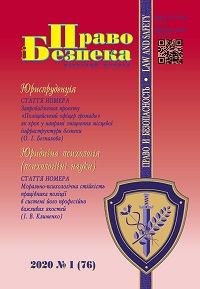Modern Scientific Approaches on Defining an Administrative Offense
DOI:
https://doi.org/10.32631/pb.2020.1.11Keywords:
administrative misdemeanor, action, offense, public harmful consequencesAbstract
The correlation of the terms of “administrative misdemeanor” and “administrative offense” has been characterized; the legal definition of “illegal act” as the main component of the content of an administrative misdemeanor has been analyzed; the main legislative features of an administrative misdemeanor have been classified, each of them has been characterized.
The author has offered classify offenses according to the following criteria: a) the degree of public danger: crimes and misdemeanors (administrative, civil, disciplinary); b) spheres of public life: in the economy, politics, social sphere, etc.; 3) forms of guilt: committed with intent and committed through negligence. It has been emphasized that an offense is a socially dangerous or socially harmful, illegal, culpable act of a tort person, which entails legal liability. Nowadays, legal science defines several types of them: constitutional and legal misdemeanor, civil misdemeanor, administrative misdemeanor, disciplinary misdemeanor, tax misdemeanor.
It has been analyzed that the current legislation actually equates the concepts of “administrative offense” and “administrative misdemeanor”, which is incorrect, because an administrative offense is inherently much broader than an administrative misdemeanor, since it includes all illegal actions that occur in the field of public management.
It has been emphasized that any violation of administrative law should be considered as an administrative offense, while an administrative misdemeanor is an illegal act, which entails the imposition of an administrative penalty according to the law.
It has been proved that the main component of the content of an administrative misdemeanor is an illegal act. It has been emphasized that the act is characterized by such legislative features as: social harm, illegality, guilt, administrative punishment. It has been noted that the absence of at least one of them makes it impossible to qualify an illegal act as an administrative misdemeanor (a tort).
Downloads
References
Skakun O.F., 2001. Theory of state and law [Teoriia derzhavy i prava]. Kharkiv: Konsum.
Kolpakov V.K. and Hordieiev V.V., 2016. The theory of administrative misconduct [Teoriia administratyvnoho prostupku]. Kharkiv: Kharkiv yurydychnyi.
Kolpakov V.K., 2005. Tort phenomenon in the administrative law of Ukraine [Deliktnyi fenomen v administratyvnomu pravi Ukrainy]. D.Sc. dissertation. National Academy of Internal Affairs of Ukraine.
Ostapenko O.I., 1997. Administrative tort [Administratyvna deliktolohiia]. Abstract of D.Sc. dissertation. National Academy of Internal Affairs of Ukraine.
Vasil`ev A.S. (ed.), 2000. Code of Ukraine on administrative offenses [Kodeks Ukrainy ob administrativnykh pravonarusheniyakh]. Kharkov: Odissei.
Komziuk A.T. (ed.), 2001. Administrative responsibility in Ukraine [Administratyvna vidpovidalnist v Ukraini]. 2nd ed. Kharkiv: Universytet vnutrishnikh sprav.
Kaliuzhnyi R.A., Komziuk A.T., Pohribnyi O.O. et al., 2008. Code of Ukraine on administrative offenses [Kodeks Ukrainy pro administratyvni pravoporushennia]. 2nd ed. Kyiv: Pravova yednist.



